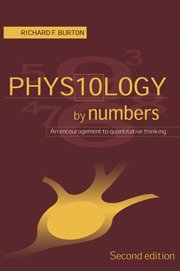Book contents
- Frontmatter
- Contents
- Preface to the second edition
- Preface to the first edition
- How to use this book
- 1 Introduction to physiological calculation: approximation and units
- 2 Quantifying the body: interrelationships amongst ‘representative’ or ‘textbook’ quantities
- 3 Energy and metabolism
- 4 The cardiovascular system
- 5 Respiration
- 6 Renal function
- 7 Body fluids
- 8 Acid–base balance
- 9 Nerve and muscle
- Appendix A Some useful quantities
- Appendix B Exponents and logarithms
- References
- Notes and Answers
- Index
How to use this book
Published online by Cambridge University Press: 06 July 2010
- Frontmatter
- Contents
- Preface to the second edition
- Preface to the first edition
- How to use this book
- 1 Introduction to physiological calculation: approximation and units
- 2 Quantifying the body: interrelationships amongst ‘representative’ or ‘textbook’ quantities
- 3 Energy and metabolism
- 4 The cardiovascular system
- 5 Respiration
- 6 Renal function
- 7 Body fluids
- 8 Acid–base balance
- 9 Nerve and muscle
- Appendix A Some useful quantities
- Appendix B Exponents and logarithms
- References
- Notes and Answers
- Index
Summary
Understand the objectives as stated in the Preface to the first edition; be clear what the book is – and what it is not. Since it is written for readers of widely varying physiological knowledge and numerical skills, read selectively. Chapters 3–9, and their individual subsections, need not be read in sequence.
Although the book is primarily about physiology, another objective is to encourage and facilitate quantitative thinking in that area. If such thinking does not come easily to you, pay particular attention to Chapter 1. Note too that the calculations are not intended to be challenging. Indeed, many are designed for easy mental, or back-of-envelope, arithmetic – and help is always to hand at the back of the book, in ‘Notes and Answers’. The notes often deal with points considered either too elementary or too specialized for the main text.
Consider carefully the validity of all assumptions and simplifications. If you try guessing answers before calculating them, you are more likely to be rewarded, in some cases, with a surprise.
If you are unfamiliar with exponents or logarithms, note the guidance given in Appendix B. The mathematics of exponential time courses are not dealt with in a single place, but most of the essentials are covered incidentally (see pages 13–16, 80–81, 98–100, 210–211, 219).
- Type
- Chapter
- Information
- Physiology by NumbersAn Encouragement to Quantitative Thinking, pp. xv - xviPublisher: Cambridge University PressPrint publication year: 2000



